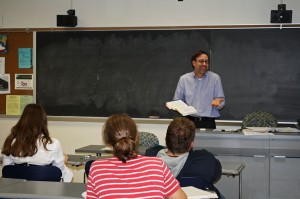Sabbaticals not to be mistaken for leisure vacation

Kimberly Morice
-Staff Writer-
When students cannot take a course offered at STLCC-Meramec, it could be because the professor is doing research to improve learning in their classroom.
“There’s a common perception among the general public, and sometimes students, that a sabbatical is a vacation for faculty and that’s not even close to what it is,” said Eric Meyer, an English professor at STLCC-Meramec who took his sabbatical in the spring of 2011. “It’s a very large project that we couldn’t do otherwise.”
Faculty members must write a proposal containing the project they wish to work on, recommendations from fellow faculty members and a description of how the college will benefit from their time on sabbatical.
Then, the sabbatical must be approved by the Board of Trustees and the campus vice president.
“I think the college almost always gets way more than what it put into a project from the faculty,” Meyer said. “[A sabbatical] releases us from our teaching duties for one semester so that we can do something that’s academic beyond the classroom.”
Meyer created materials that his fellow English professors may use to “establish the importance and nature in writing among a variety of disciplines.” He wanted to create multimedia materials for first-year college composition students.
Meyer gathered his materials by traveling the country at his own expense, interviewing students and faculty about college writing.
Meyer talked to seven former Meramec students and six faculty members in various disciplines, including biology, history and graphic design.
Once Meyer returned to teaching, he realized that all of the material he had acquired was much more than he had anticipated. He decided that once he had finished with what he had set out and promised to do for the college, he would begin working on a separate project that would become useful for the college.
“What happened was I got an unbelievably high amount of unbelievably high-quality interview footage. It’s shaped up into what will be an actual full blown documentary film about college writing,” Meyer said. “I have delivered what I said I was going to deliver by the deadline, now a new project has grown out of that. I’m not still working on my sabbatical project, I’m taking what I did there and now I’ve expanded it into a much bigger project.”
Meramec Political Science Professor John Messmer looked at efforts to improve St. Louis regionalism with particular attention toward the city and county split as well as efforts toward a political merger and local government coordination.
“I wanted to spend most of my time — and this was all in my proposal — about surveying people that I had never heard surveyed about the subject. I wanted to survey the politicians,” Messmer said.
To cut down on cost and make it more technologically savvy, Messmer emailed a link to his online survey to over 700 politicians in the St. Louis City and County and visited a dozen people who met them.
“This college represents the St. Louis community coming together; it represents that every day, and it certainly represents it back when the college started off in the early 60s,” Messmer said. “St. Louis Community College brings together the St. Louis area for one common purpose: affordable undergraduate education.”
Both Meyer and Messmer have completed their sabbatical projects. Though, they both continue to improve them on their own time and plan to incorporate their findings into the Meramec library.
“The most obvious result of this is a collection of data which is going to keep me busy for years,” Messmer said.











